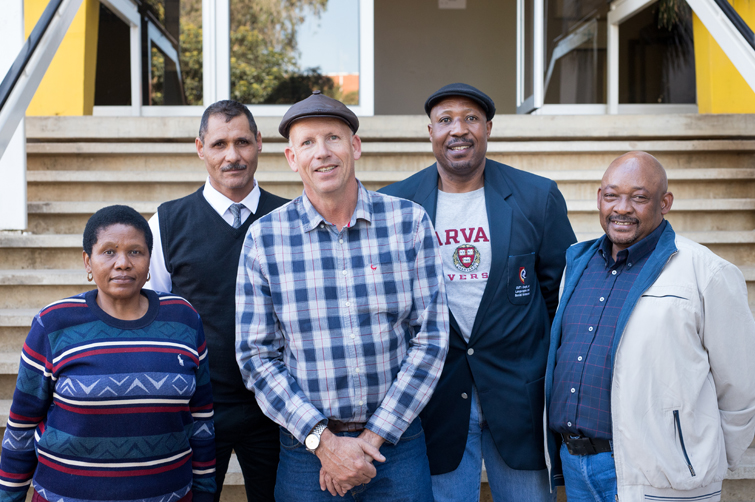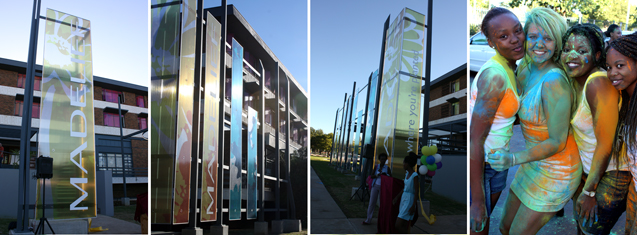Latest News Archive
Please select Category, Year, and then Month to display items
13 January 2020
|
Story Eugene Seegers
|
Photo Anja Aucamp
 Spearheading the digital expansion of the conversational Sesotho course is IDEAS Lab Director, Johann Möller (middle). With him are from the left: Prof Pule Phindane, CUT; Dr Brenton Fredericks, CUT; Bahedile Letlala, UFS Department of African Languages; and Dr Elias Malete, UFS Department of African Languages.
Spearheading the digital expansion of the conversational Sesotho course is IDEAS Lab Director, Johann Möller (middle). With him are from the left: Prof Pule Phindane, CUT; Dr Brenton Fredericks, CUT; Bahedile Letlala, UFS Department of African Languages; and Dr Elias Malete, UFS Department of African Languages.
For many years now, the UFS has been offering a one-year course in conversational Sesotho for staff members; this can then be followed up with the one-year course in advanced conversational Sesotho. The conversational Sesotho for students in the Faculty of Education was introduced in 2018 at the UFS.
The Central University of Technology (CUT) needed a conversational course for its first-year students and approached the Department of African Languages for the development of such a course. Living as we do in a multilingual country; this additional language skill opens doors and often hearts as well.
Using instructional design principles
However, the need was identified by both CUT and UFS to present this crucial information in a way that would be more appealing to digital natives as well as to those less familiar with technology. The Department of African Languages on the UFS Bloemfontein Campus, together with relevant departments from the CUT, approached the IDEAS Lab located on the UFS South Campus, since they already have a reputation for being a specialist on broadcasting and repackaging curricular content for digital presentations. The IDEAS Lab provided technical advice and built the multimedia programme, which will help the user to hear and practice phrases in Sesotho, using instructional design principles. The course will be available to both staff and students belonging to the two universities.
Room for growth
Johann Möller, Director of the IDEAS Lab, says this pilot programme will give both institutions the opportunity to test the use of multimedia for language acquisition. He adds, “Language is extremely complex, and we would like to expand this learning aid in the future.” In fact, the original design has room for growth built into it.
To keep things simple for the user and the building team, it was decided to start out with only four potential everyday scenarios where a staff member would like to speak Sesotho: Firstly, how to greet other persons from different genders; secondly, potential scenarios one might encounter in the university environment itself; thirdly, how to deal with situations at a hospital; and finally, how to use one’s language skills at a filling station.
Pronunciation is key
Each scenario contains three to four conversations that the learner can revise, along with images and audio that illustrate the situation and assist with correct pronunciation. The system does not allow the user to progress unless they have listened to the pronunciations of the sample sentences or phrases.
Further reading material and vocabulary lists are also provided, with the result that people who are using the programme can learn at their own pace. The authoring software Articulate Storyline was used to build the individual scenarios and each conversation or lesson within it. The lessons are also not dependent on an internet connection; they can be downloaded onto a flash memory drive and used offline.
Madelief Residence bursts into colour
2014-03-12

You’ll be forgiven for thinking that your eyes are deceiving you when turning into the main entrance to the Bloemfontein Campus. Yet, it is still the graceful old lady of a building called Madelief. This 50-year-old female residence has donned a sparkling new ‘dress’, brandishing a trendy new look.
After extensive renovations kicked off during October last year, the long-awaited revamp left residents and Kovsies astonished. The makeover transformed the building into a sparkling gem, glistening in the Free State sun. Luminescent contra-vision windows, a remodelled veranda and a new façade propel this residence into modernity. A unique twist to the use of the façade is that it is reflective during both the day and night. During the daytime, the light reflects towards the residence and during the night it mirrors the entrance of the university. This feature lends an innovative and vibrant impression to the residence’s appearance.
“I’m so happy for my residence. It’s now the hub of attraction – everyone wants to visit and come have a look. Thanks to our Residence Head, the constructors and designers who came up with this concept and Housing and Residence Affairs. We look 50 years younger indeed and more vibrant,” Mamnosi Tshabalala, a senior resident at Madelief, beamed.
In celebration of this new phase of their residence, students plunged into a festival of colour – power paint exploding into rainbows over anyone who came near. Top management that attended the celebration could not escape the excitement. Profs Jansen and Morgan, Dr Wahl, Mr Koetaan and Rudi Buys were swept into the good cheer, snapping photos and making fantastic memories.